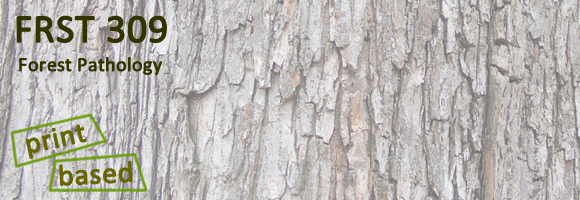
Mode of Delivery
This is a print-based, correspondence course.
Course Outline
- Three assignments
- Lab session
- Final exam
Course Description
Forestry 309 – Forest Pathology. Biology and management of forest tree diseases.
Prerequisite: Forestry 204 (or equivalent)
Intended Student
The prospective student must have completed a course in forest ecology. That prerequisite, in turn, implies the further requirement of courses in soil science and dendrology. In addition, a course in climatology, with particular emphasis on microclimate, is highly recommended. Field experience in the coniferous forests of western North America will also be an invaluable asset.
Forest tree diseases affect both above- and below-ground parts of trees. Since diseases are always greatly influenced by the immediate environment, a good grasp of the soil environment and of microclimate is important for the understanding of diseases. A good grasp of normal tree form and function, such as presented in a dendrology course, is also essential before abnormalities resulting from disease can be understood. Finally, diseases play a major role in virtually all forest ecosystems, and their control is almost wholly achieved by ecosystem manipulation. Thus familiarity with ecosystem classification, succession, and ecosystem processes is essential both to understand how diseases affect these, and how, by appropriate manipulation, the impact of diseases on management goals can be minimized.
This course is designed for:
- students who wish to complete part of the requirements for a B.S.F. (Forest Resource Management or Forest Harvesting) or B.Sc. (Forest Sciences) degree through independent study;
- pupils within the ABCPF program who want to complete the course requirement in forest pathology; and
- any person who wants to learn more about forest pathology.
Course Objectives
This course is designed primarily for students who want to prepare for a career in forestry. It differs from a nomal first course in plant pathology in that it does not attempt to give a complete survey of the field. Rather, the material selected for study consists of those aspects of tree disease that are most likely to be relevant to foresters making silvicultural decisions about stands of trees.
Upon completion of this course you will:
- be able to recognize and identify the common diseases of the Pacific coast forests;
- be able to recognize and interpret disease signs and symptoms on forest and shade trees around the world;
- know enough about the biology and epidemiology of the common and damaging diseases of Pacific coast conifers to deal with them effectively by appropriate silvicultural prescriptions.
Course Content
This course is divided into eight lessons:
- Introductionto forest pathology
- Decay
- Root diseases
- Wilt, foliage, bark, and seedling diseases
- The rusts
- The dwarf mistletoes
- Inheritance of resistance
- Forest pathology in the context of forestry practices
Evaluation
The grade for the course work will be broken down into the following percentages:
| 3 Assignments | 30% |
| Specimen Collection | 10% |
| Lab Report | 10% |
| Final Examination | 50% |
| Total | 100% |
In order to pass the course, students must:
- complete and submit all assignments before writing the final examination;
- submit a specimen collection;
- attend the lab session and submit a report;
- obtain a passing mark (>50%) on the examination;
- obtain an overall passing mark in the course.
Textbook and Course Materials
- Edmonds, R.L., Agee, J.K.& Gara, R. 2000. Forest Health and Protection. McGraw-Hill Higher Education.
- FRST 309 Learner Package (includes course manual)
